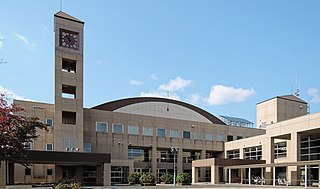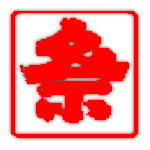
Sakanoue no Tamuramaro was a court noble, general and shōgun of the early Heian period of Japan. He served as Dainagon, Minister of War and Ukon'e no Taisho. He held the kabane of Ōsukune and the court rank of Junior Second Rank and was awarded the Order of Second Class. He was the son of Sakanoue no Karitamaro.

Hirosaki is a city located in western Aomori Prefecture, Japan. As of 1 February 2023, the city had an estimated population of 163,639 in 71,044 households, and a population density of 310 per square kilometre (800/sq mi). The total area of the city is 524.20 square kilometers (202.39 sq mi).

Hanami is the Japanese traditional custom of enjoying the transient beauty of flowers; flowers in this case almost always refer to those of the cherry or, less frequently, plum trees. From the end of March to early May, cherry trees bloom all over Japan, and around the second week of January on the island of Okinawa. The blossom forecast "cherry blossom front" is announced each year by the Japan Meteorological Agency, and is watched carefully by those planning hanami as the blossoms only last a week or two.

Tsuruta is a town located in Aomori Prefecture, Japan. As of 31 January 2023, the town had an estimated population of 11,968 in 5355 households, and a population density of 260 persons per km2. The total area of the town is 46.4 square kilometres (17.9 sq mi). The name "Tsuruta" is a combination of the character for crane (鶴) with that for rice field (田).

Yasaka Shrine, once called Gion Shrine, is a Shinto shrine in the Gion District of Kyoto, Japan. Situated at the east end of Shijō-dōri, the shrine includes several buildings, including gates, a main hall and a stage. The Yasaka shrine is dedicated to Susanoo in the tradition of the Gion faith as its chief kami, with his consort Kushinadahime on the east, and eight offspring deities on the west. The yahashira no mikogami include Yashimajinumi no kami, Itakeru no kami, Ōyatsuhime no kami, Tsumatsuhime no kami, Ōtoshi no kami, Ukanomitama no kami, Ōyatsuhiko no kami, and Suseribime no mikoto.

Hirosaki Castle is a hirayama-style Japanese castle constructed in 1611. It was the seat of the Tsugaru clan, a 47,000 kokutozama daimyō clan who ruled over Hirosaki Domain, Mutsu Province, in what is now central Hirosaki, Aomori Prefecture, Japan. It was also referred to as Takaoka Castle.

The Gion Festival is one of the largest and most famous festivals in Japan, taking place annually during the month of July in Kyoto. Many events take place in central Kyoto and at the Yasaka Shrine, the festival's patron shrine, located in Kyoto's famous Gion district, which gives the festival its name. It is formally a Shinto festival, and its original purposes were purification and pacification of disease-causing entities. There are many ceremonies held during the festival, but it is best known for its two Yamaboko Junkō (山鉾巡行) processions of floats, which take place on July 17 and 24.

Nisei Week is an annual festival celebrating Japanese American (JA) culture and history in Little Tokyo, Los Angeles. Nisei means 2nd generation in Japanese, describing the first American born Japanese, a group which the seven-day festival was originally meant to attract. Though named for the Nisei generation, Nisei Week is no longer targeted at Niseis, nor is the festival still contained within a week. Nisei Week Foundation president for 2006, Michelle Suzuki, described the festival as "the opportunity for people of all backgrounds to celebrate Japanese heritage and culture".

Danjiri Matsuri are cart-pulling festivals held in Japan. The Kishiwada Danjiri Matsuri is probably the most famous. There are other Danjiri Matsuri held in the City of Kobe and Haruki Town, but they are less popular and spectacular. The highlight of the Festival is a race between floats representing different neighborhoods.

The Aomori Nebuta Matsuri is a Japanese summer festival that takes place in Aomori, Aomori Prefecture, Japan in early August. The festival attracts the most tourists of any of the country's nebuta festivals, and is counted among the three largest festivals in the Tōhoku region. It was designated an Important Intangible Folk Cultural Property in 1980, and as one of the 100 Soundscapes of Japan by the Ministry of the Environment in 1996.

Iwakiyama Shrine is a Shintō shrine in the city of Hirosaki in Aomori Prefecture, Japan. It is the ichinomiya of former Tsugaru Domain. All of Mount Iwaki is considered to be a portion of the shrine.
There are many festivals held in the city of Nagoya in central Japan. These festivals (matsuri) take place throughout the year. Apart from the main national festivals and holidays, which are celebrated across the entire country, Nagoya has its own unique festivals. Major events include the Atsuta Festival at Atsuta Shrine in June, the Port Festival at Nagoya Port in July, the Nagoya Castle Summer Festival in August, and the Nagoya Festival at the Hisaya Ōdori Park in October. Various smaller festivals exist, and different wards and areas of the city have their own local festivals.

The Akita Kantō (秋田竿燈まつり) is a Japanese festival celebrated from 3–7 August in Akita City, Akita Prefecture in hope for a good harvest. Around two hundred bamboo poles five to twelve metres long, bearing twenty-four or forty-six lanterns, topped with gohei, and weighing up to fifty kilograms, are carried through the streets by night on the palms, foreheads, shoulders, or lower backs of the celebrants. The festival is first referred to in a travel diary of 1789 The Road Where the Snow Falls (雪の降る道). It is one of the main festivals in Tōhoku, along with the Tanabata festival in Sendai, the Aomori Nebuta Matsuri festival, and the Yamagata Hanagasa Festival in Yamagata. The Akita Kantō festival was designated an Important Intangible Folk Cultural Property in 1980.

The Goshogawara Tachineputa Festival is a Japanese summer festival which takes place every August in Goshogawara, Aomori Prefecture, Japan. It is known as one of the four largest festivals in the Tsugaru region of Japan, along with the Aomori Nebuta Festival, the Hirosaki Neputa Festival, and the Kuroishi Yosare Festival. The Goshogawara Tachineputa Festival is notable for its large tachineputa floats, which are much taller than those found in the Aomori and Hirosaki Festivals. The tachineputa floats stand at 23 meters in height and weigh 19 tons. The start of the festival is marked with a fireworks show on August 3, with the parade beginning on August 4 and continuing through August 8th.

The Nebuta Museum Wa Rasse is a city-owned museum near Aomori Station in the city of Aomori in northern Japan. It displays a revolving exhibit of four Nebuta floats from the most recent Aomori Nebuta Matsuri summer festival, alongside media related to the festival. The museum opened in January 2011.

Shimizu Park (清水公園) is a privately owned park located in Noda City in north-eastern Chiba prefecture about 65 kilometers north of Tokyo. It is located 200 meters west-north-west of Shimizu-kōen Station on the Tōbu Urban Park Line, which is roughly 30 km east of its terminus in central Saitama city.


























